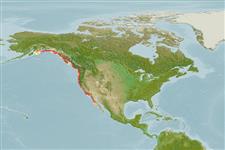>
Perciformes/Scorpaenoidei (Scorpionfishes) >
Sebastidae (Rockfishes, rockcods and thornyheads) > Sebastinae
Etymology: Sebastes: Greek, sebastes = august, venerable (Ref. 45335); caurinus: From the Latin caurinus, meaning 'northwest' (Ref. 27436).
More on author: Richardson.
Environment: milieu / climate zone / depth range / distribution range
Ökologie
seewasser demersal; tiefenbereich 10 - 183 m (Ref. 2850). Subtropical; 60°N - 27°N, 152°W - 114°W
Eastern Pacific: Kenai Peninsula, Gulf of Alaska to central Baja California, Mexico. The darker reddish phase from California may be a separate species (Ref. 27437).
Length at first maturity / Size / Gewicht / Alter
Maturity: Lm 34.0, range 31 - 41 cm
Max length : 58.0 cm TL Männchen/unbestimmt; (Ref. 27437); max. veröff. Gewicht: 2.7 kg (Ref. 40637); max. veröff. Alter: 57 Jahre (Ref. 5483)
Rückenflossenstacheln (insgesamt): 13; Rückenflossenweichstrahlen (insgesamt): 11-14; Afterflossenstacheln 3; Afterflossenweichstrahlen: 5 - 7; Wirbelzahl: 25 - 26. Head spines strong - nasal, preocular, postocular, tympanic and parietal spines present, supraocular, coronal and nuchal spines absent (Ref. 27437). Caudal fin rounded (Ref. 6885). Olive brown to copper with pink or yellow blotches, white on sides and belly; rear two thirds of lateral line is white; usually with two dark bands radiating from eye; dorsal fin dark copper brown to black with some white (Ref. 27436). Branchiostegal rays: 7 (Ref. 36715).
Particularly abundant in shallow, protected bays and inlets, among rocks and kelp beds; also found around pilings and jetties or under floats (Ref. 27436). Juveniles found in loose aggregations in shallow weedy bays, around wharfs, or among floating drift associated with summer tidelines (Ref. 27436). Mainly a benthic feeder, may also take pelagic fishes (Ref. 27436). Viviparous, with planktonic larvae (Ref. 36715). Flesh is tasty, firm and flaky (Ref. 27436). Sold mainly as fresh fillets or live in Chinese restaurants and fish markets; excellent for fish chips or for pan frying as fillets (Ref. 27436).
Eschmeyer, W.N., E.S. Herald and H. Hammann, 1983. A field guide to Pacific coast fishes of North America. Boston (MA, USA): Houghton Mifflin Company. xii+336 p. (Ref. 2850)
IUCN Rote Liste Status (Ref. 130435)
Nutzung durch Menschen
Fischereien: weniger kommerziell; Sportfisch: ja; Aquarium: Öffentliche Aquarien
Mehr Information
ReferenzenAquakulturAquakultur ProfilZuchtlinienGenetikElectrophoresesVererbbarkeitKrankheitenVerarbeitungNutrientsMass conversion
Tools
Zusatzinformationen
Download XML
Internet Quellen
Estimates based on models
Preferred temperature (Ref.
123201): 6.5 - 10, mean 8.3 °C (based on 53 cells).
Phylogenetic diversity index (Ref.
82804): PD
50 = 0.5000 [Uniqueness, from 0.5 = low to 2.0 = high].
Bayesian length-weight: a=0.01000 (0.00499 - 0.02004), b=3.09 (2.92 - 3.26), in cm total length, based on LWR estimates for this Genus-body shape (Ref.
93245).
Trophic level (Ref.
69278): 4.1 ±0.5 se; based on diet studies.
Widerstandsfähigkeit (Ref.
120179): niedrig, Verdopplung der Population dauert 4,5 - 14 Jahre. (K=0.12; tmax=55; tm=4; Fec=20,000).
Prior r = 0.18, 95% CL = 0.12 - 0.28, Based on 1 stock assessment.
Fishing Vulnerability (Ref.
59153): Moderate to high vulnerability (49 of 100).
Nutrients (Ref.
124155): Calcium = 47.8 [14.1, 149.9] mg/100g; Iron = 0.676 [0.278, 1.809] mg/100g; Protein = 18.6 [17.5, 19.8] %; Omega3 = 0.696 [0.303, 1.610] g/100g; Selenium = 70.3 [25.8, 227.2] μg/100g; VitaminA = 21.3 [7.3, 64.1] μg/100g; Zinc = 0.456 [0.229, 0.865] mg/100g (wet weight);
